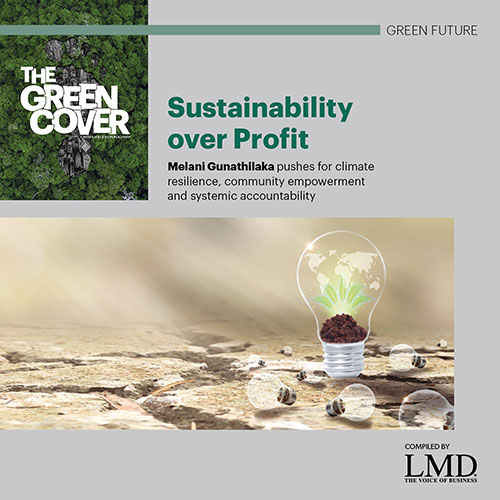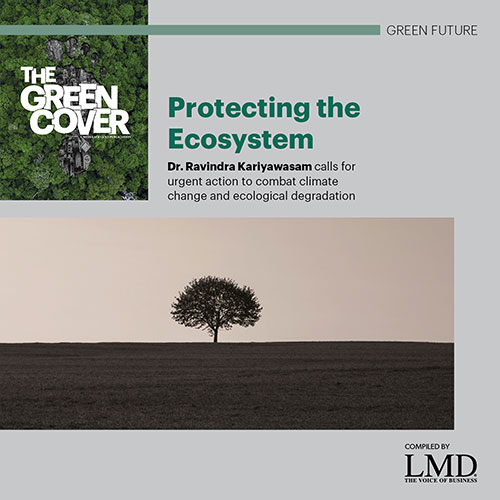ALTERNATIVE ENERGY
Sustainable Power Generation
Chamil Silva offers insight s into Sri Lanka’s energy mix and path to achieving its renewable energy goals
As the stakes grow higher each year in the fight to save the environment, it is vital now more than ever for countries to adopt renewable energy sources – Sri Lanka is no exception.
According to Chamil Silva – the Co-Founder and Managing Director of Solarray Energy, and President of the Bio-Energy Association of Sri Lanka (BEASL) – a primary reason for the country’s recent energy crisis is an unwarranted halting of the development of renewable energy sources. “It’s important that the government supports the private sector in developing renewable energies,” he says.
Drawing on over 15 years of experience in the sector, he categorises renewable energy into two types – viz. intermittent and non-intermittent.
Silva elaborates: “We have implemented a mix of non-conventional renewables in Sri Lanka – mini-hydro, ground mounted and rooftop solar, and wind, which are unpredictable sources; and biomass, which is derived from wood chips or agricultural waste, and provides firm or non-intermittent power. This should be developed to pave the way for the future of renewable energy in the country.”
In line with the UN’s Sustainable Development Goal (SDG) 7 – ensuring access to affordable, reliable, sustainable and modern energy – the government set clear goals to have 70 percent of Sri Lanka’s electricity generated from renewables by 2030 with a target of net zero emissions by 2050.
“We have implemented a mix of non-conventional renewables in Sri Lanka… This should be developed to pave the way for the future of renewable energy in the country
Silva, who also plays a major role in the Solar Industries Association, feels Sri Lanka is on the right path to the wide adoption of renewable energy – its current energy mix largely comprises mini-hydro, solar and wind.

“In the local context, we have clear policy guidelines to achieve this forward-looking master plan, in addition to making strategic investments in infrastructure improvements where necessary. So for the moment, I believe we are well positioned to achieve these targets,” he remarks.
In Silva’s view, the driving force of renewable energy development has been the private sector: “So far, Sri Lanka has around 1,573 MW of renewable energy, comprising 429 MW of mini-hydro, 249 of wind, 132 MW of ground mounted solar, 700 MW of rooftop solar and 63 MW of biomass. Of this, a 100 MW wind farm was developed by the Ceylon Electricity Board (CEB) and the remaining sources by the private sector.”
Owing to this, he believes that the government should continue facilitating private sector investments in renewable energy in the years to come to add the 2,346 MW of renewables expected by 2026.
As the President of BEASL and Treasurer of the Federation of Renewable Energy Developers, which is affiliated with the Ceylon Chamber of Commerce, Silva plays a significant role in promoting energy efficiency among the general public. He notes that one way to promote conscious energy use is the introduction of a cost reflective tariff scheme.
“Since around 2012, there haven’t been tariff increases for consumers and costs associated with producing electricity were borne by the government. For various reasons, administrations have lived with non-cost reflective tariff over the last 10 years,” he explains.
He continues: “This tremendously impacted CEB’s revenue and created a huge backlog of payments to renewable energy developers that exceeds Rs. 35 billion over a period of more than a year. While CEB has been able to settle some of the dues to rooftop solar developers up to December last year, the way forward for renewable power plants with capacities below 10 MW is unclear.”

In Sri Lanka, an estimated 4.8 million of seven million consumers use 90 units or less while the rest have a much higher consumption. Silva observes: “This was the reason for the energy crisis we faced last year as most of the imported fuel was for power generation and not transportation. Due to this, our foreign exchange depleted as well.”
The solution was a tariff increase to reflect the true cost, which prompted high energy users to either manage their demand or look for alternatives such as solar rooftop installations. For corporates, reducing their carbon footprints has led to higher marketability of their products as well.
“In terms of economic benefits, renewable energy merely requires an initial capital expenditure. Thereafter, it’s basically free over the project’s lifetime,” he adds.
To Silva, the solution is clear: “To avoid the worst impacts of climate change, emissions need to be reduced and switching to clean sources of energy not only helps address climate change, but also the economic development and overall health of a nation.”
“We expect the government to facilitate the private sector in achieving renewable energy development targets; clear the backlogs of due payments, in turn inculcating trust in investors and bankers; and provide a conducive feed-in tariff for renewables – a process that has taken over a year without promising outcomes,” he maintains.
Chamil Silva can be contacted at suranga.silva@solarrayenergy.lk.






